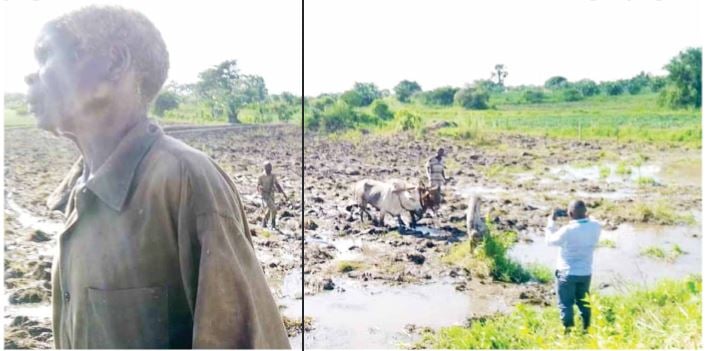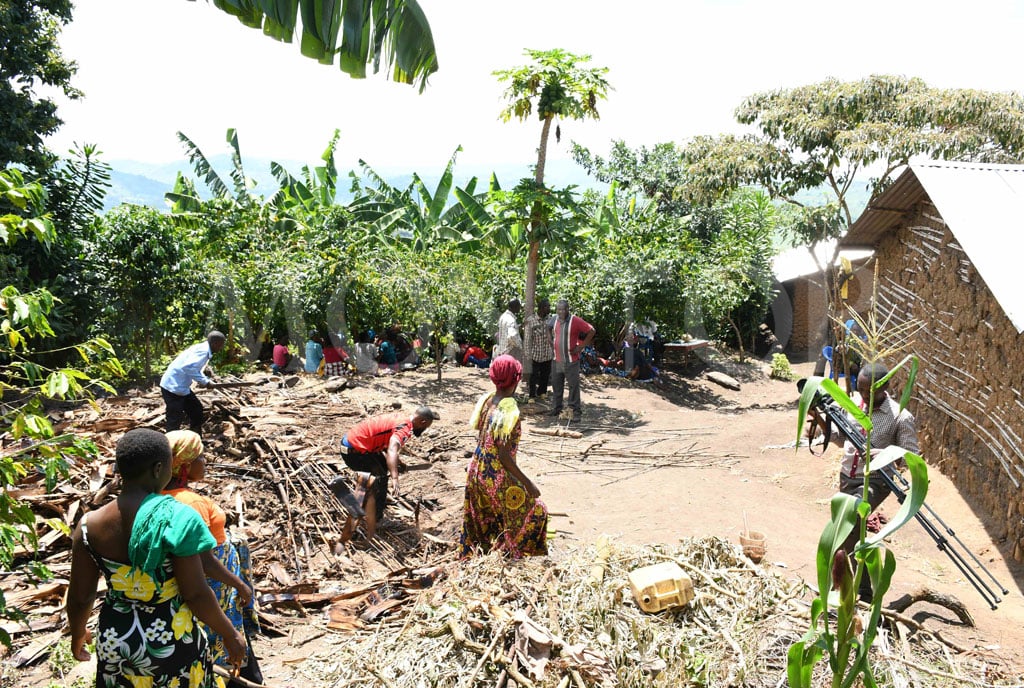Prime
Why Aswa’s fragile ecosystems spell doom for northeastern Uganda

Many farmers in northeastern Uganda farm in wetlands in a desperate search for
alternative livelihoods to recover from climatic shocks. PHOTO | BILL OKETCH
What you need to know:
- Currently, about 20 percent of the Aswa River Basin is degraded. Farmers across the region have been vulnerable to starvation in times of extreme weather events and as a result, their means of increasing food production has always been expansion of area under cultivation – from virgin to fragile areas, especially wetlands.
For the last 16 years, a group of more than 700 smallholder farmers have been growing yams, rice, and sugarcane along the bank of River Olupe Opong in Geregere sub-county, in Agago District. Unfortunately, their desperate search for alternative livelihoods to recover from the effects of climatic variations in the Lango sub-region, has led to the degradation of this critical ecosystem.
The Olupe Opong riverbank forms part of the fragile Aswa River Basin, which is home to a dense network of seasonal and permanent marshes. Others are Adungo riverbank in Kapelebyong and Amuria districts, Ogwete wetland system in Otuke district, and Karakilet-Lokokokwayi and Kadukuye riverbank in Kitgum district, among others.
Currently, about 20 percent of the Aswa River Basin is degraded. Farmers across the region have been vulnerable to starvation in times of extreme weather events and as a result, their means of increasing food production has always been expansion of area under cultivation – from virgin to fragile areas, especially wetlands.
Christine Atim, a farmer in Akaidebe Cell, Barodugu Ward in Otuke Town Council, is aware that the law does not allow people to engage in agricultural activities within the wetlands.
“The changes in the rainfall patterns have driven us to farm in the wetlands. If we do not farm in the wetlands, hunger will surely kill us. In the past, rain used to return in March but here in Otuke, it started raining this week yet the month of July is almost ending. This is the time when we should have been harvesting the crop planted in the first season,” she says.
Gasper Okello, an LC5 councilor and farmer, confirms that due to changes in rainfall patterns, farmers’ indigenous knowledge on forecasting sometimes does not work.
“Even when they rely on scientific data, sometimes it is not very accurate. For the last eight years, we have suffered losses due to heat waves and prolonged dry spells. As a result, many now see wetlands as virgin farm land waiting to be grabbed,” he says.
Okello adds that there is a lack of sufficient knowledge among farmers about the importance of wetlands or the relationship between wetlands and rainfall.
“The government is telling people that wetlands are no-go areas but they are not providing alternative sustainable livelihoods that can entice people to abandon wetlands,” he says.
Data from the Ministry of Water and Environment shows that over 80 per cent of the population directly use wetland resources for their household food security needs. As of 2019, the Aswa River Basin had lost 680 square kilometres of wetlands in a span of 20 years due to crop cultivation, exacerbated by biophysical factors.
As a result, the Aswa freshwater ecosystems are experiencing increased siltation, reduced water flow and water quality, and declining ability to check storm run-off and floods.
Negative consequences
Covering an area of over 27,677 square kilometres, the Aswa River Basin encompasses the 15 districts of Abim, Agago, Alebtong, Amuria, Amuru, Gulu, Kaabong, Kitgum, Kole, Kotido, Lamwo, Lira, Otuke, Oyam, and Pader.
Its freshwater ecosystems are a key source of water for domestic use and farming, firewood, charcoal, pasture, fish, sand, and raw materials for the local handicraft industry. The ecosystems also provide crucial cultural services for the community.
However, as a result of human activities within the catchment, some water sources in Otuke, Pader and Agago districts dry up the moment the dry season sets in.
Leonard Opio Ojok, the LC5 chairperson of Agago district and the chairman of Aswa Catchment Management Organisation, says people who are encroaching on wetlands are only looking at the short-term benefit of using wetlands like cultivating rice and other crops.
“The main challenge is changing the mindset. Much as there are people who have understood and appreciated the importance of protecting water resources, there are those who look at the immediate short-term benefits. We need to continue sensitising the community so that they know farming in wetlands will interfere with the rainfall patterns, which, in turn, will lead to starvation and lack of money for paying school fees,” he says.
Most of the wetlands in the district are not demarcated and this poses challenges in conserving them. As a result, there is loss of biodiversity and habitat for some plant and animal species.
Isaiah Ndungo, the country coordinator for Join for Water, an organisation which guarantees water for people and nature alike, says the significant environmental challenges the Aswa River Basin is currently facing have an impact on the availability and quality of local water resources.
“Because of the degradation, flash floods, recurring droughts and other extreme weather events are intensifying. This is exacerbating water insecurity. Unfortunately, local government and central government authorities have institutional challenges in water governance. There is limited harmonization of institutional mandates between the authorities and they do not have sufficient data on the status of the different wetlands to facilitate decision-making,” he says.
Ndungo adds that the lack of community inclusion is also not helping matters.
“There is weak stakeholder engagement. For example, the public is not invited to participate in planning for how the ecosystems can be restored. There are no community-led water management initiatives,” he says.
In 2017, the Ministry of Water and Environment developed a Catchment Management Plan (CMP) for the Aswa Catchment. Its aim was to provide information and a shared motivation to initiate interventions and/or investments towards water resource protection.
“While a CMP provides a framework for water resource protection and management, it lacks detailed insights into what is driving people into encroachment and the pressures on water resources. It also lacks a detailed evaluation of the state of water ecosystems,” Ndungo says.
Call for action
Joel Okao Tema, the secretary for Trade, Industry, Economy and Investments in the Forum for Democratic Change (FDC) Party, decries what he terms as “endless and feeble orders” that President Yoweri Museveni has been issuing to evict wetland encroachers.
“It is tempting to believe such orders. However, when one looks at the litany of them that remain unenforced over several years, one forms the sad conclusion that the people who receive the president’s orders no longer take him seriously. The government must end the madness of issuing land titles in wetlands to investors,” he says.
Okao adds that land acquisition is part of one’s investment costs, saying it must be the responsibility of the investor to source and buy land needed for his or her investment.
“Wetlands belong to Ugandans and the government is only entrusted to manage them for posterity; not to dish them out to investors as if the future will somehow not need them,” he says.
According to him, the continued destruction of wetlands in the name of building factories stands in contrast to the position of Uganda Vision 2040.
“Vision 2040 states that Ugandans desire a green economy and clean environment where the ecosystem is sustainably managed and the livability of the urban systems greatly improved. As we race towards Vision 2040 to attain the sustainable development goals, it is urgent and crucial that the government moves quickly to ensure that encroachers on wetlands restore them,” Okao says.
Not all is lost, though. Join for Water has kicked off a study to assess the current socio-economic, environmental and institutional challenges related to water resources protection and management in Aswa II sub-catchment.
“We will conduct meetings with communities and their leaders in the target area. The study will not only explore and identify opportunities related to water resources management and catchment protection. It will form a knowledge base that will help to identify priorities and an action portfolio for future interventions in the region,” Ndungo says.
As one of the strategies to conserve and protect water resources, district local governments in the region are also in the process of demarcating all wetlands in their areas.
Today, Adungo riverbank in Kapeleyong and Amuria districts, Ogwete wetland system in Otuke district, Olupe Opong riverbank, and Karakilet-Lokokokwayi and Kadukuye riverbank in Kitgum district – all within Aswa catchment – have been demarcated.
In Agago, for example, local leaders started the demarcation process at one of the streams in Patongo Town Council. John Okidi, Agago’s acting environment officer, says funds have been earmarked for the demarcation exercise.
“The district council will ensure that, at least every financial year, money is allocated to demarcate some length within the wetland. So far, only Unyama, Olupe and Lucolo wetlands have been demarcated. We have also begun to sensitise the community so that they know the value of these wetlands, and can take the initiative to protect or sustainably utilise them,” he says.
The district is also developing an ordinance on wetlands that will go a long way in enforcing the existing laws on wetlands and the environment.
“We have already submitted the draft ordinance to the office of the Attorney General but that one is only for complimentary purposes because we have several legal provisions for protecting water resources,” Opio Ojok, Agago district’s LC5 chairperson says.
Some of the legal provisions include the Water Act Cap 152 (1997) which provides for the use, protection and management of water resources and supply; and facilitates the devolution of water supply and sewerage undertakings; and the National Environment Act (2019) which places on every person the duty to create, maintain and enhance the environment, including preventing pollution.
Following several engagements between the Ministry of Water and Environment and local leaders in Agago district, the encroachers have started voluntarily vacating wetlands and riverbanks in the Aswa catchment.
Data from the Water and Sanitation Development Facility of the Ministry of Water and Environment shows that 5,589 hectares of degraded wetlands have been restored through demarcation of 77 kilometres of the wetland boundaries in Aswa catchment. About 255 hectares of degraded riverbanks have also been restored by demarcating 85 kilometres of the riverbank boundaries.
This intervention was implemented under the Enhancing Resilience of Communities to Climate Change through Catchment Based Integrated Management of Water and Related Resources in Uganda (EURECCCA) project.
Accordingly, 3,472 households affected by the demarcation of the wetlands and riverbanks in northeastern Uganda have been given Shs1 billion in the form of revolving funds to enable them engage in income generating activities.
The project overall goal is to increase the resilience of communities to the risk of floods and landslides in Awoja catchment in Kyoga Water Management Zone, Maziba catchment in Victoria Water Management Zone and Aswa catchment in Upper Nile Water Management Zone, through promoting catchment based integrated, equitable and sustainable management of water and related resources.




